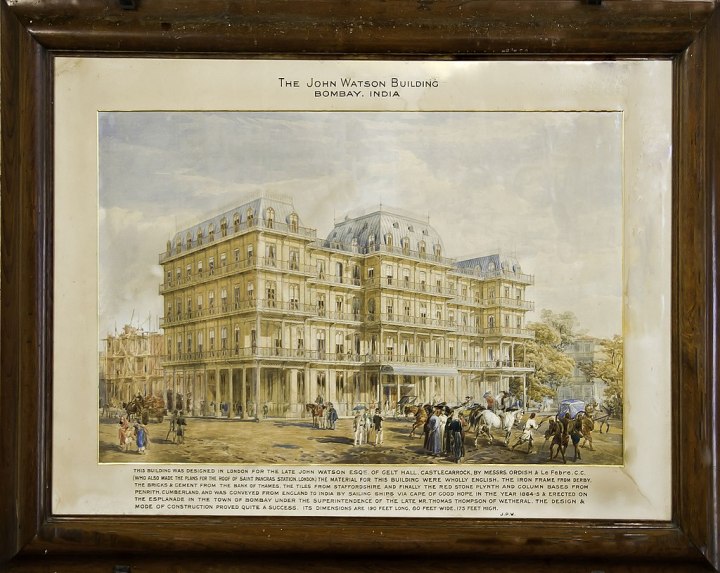This picture shows you, what used to be the grand Watson’s Hotel in Bombay. This ghost of a building known today as Esplanade Mansion, quietly awaits its fate in the Fort area of Mumbai. But before its sad demise, the hotel saw many glittering days and equally glittering people.
In 1896, an American author and satirist came to India. He had made much money in his writings, the most famous of which include the Adventures of Huckleberry Finn and The Adventures of Tom Sawyer. But the money soon disappeared. The author’s visit to India was part of a world tour, where he planned to address audiences, and do some book readings, all for a price, of course. He hoped to recoup his fortune through this tour. And that is how, Samuel Clemens, aka Mark Twain, came to India. He was completely bowled over by everything around him.
The passage below is from Mark Twain’s 1897 travelogue, Following the Equator:
“In his straddling wide forward step, and his springy sidewise series of hops, and his impudent air, and his cunning way of canting his head to one side upon occasion, here minds one of the American blackbird. But the sharp resemblances stop there…. I never saw such a bird for delivering opinions. Nothing escapes him; he notices everything that happens, and brings out his opinion about it, particularly if it is a matter that is none of his business. And it is never a mild opinion, but always violent—violent and profane–the presence of ladies does not affect him. His opinions are not the outcome of reflection, for he never thinks about anything, but heaves out the opinion that is on top in his mind and which is often an opinion about some quite different thing and does not fit the case. But that is his way; his main idea is to get out an opinion, and if he stopped to think he would lose chances.
…If I sat on one end of the balcony, the crows would gather on the railing at the other end and talk about me; and edge closer, little by little, till I could almost reach them; and they would sit there, in the most unabashed way, and talk about my clothes, and my hair, and my complexion, and probable character and vocation and politics, and how I came to be in India, and what I had been doing, and how many days I had got for it, and how I had happened to go unhanged so long, and when would it probably come off, and might there be more of my sort where I came from, and when would they be hanged, – and so on, and so on, until I could not longer endure the embarrassment of it; then I would shoo them away, and they would circle around in the air a little while, laughing and deriding and mocking, and presently settle on the rail and do it all over again.”

This is what he said of Bombay. “Bombay! A bewitching place, a bewildering place, an enchanting place – the Arabian Nights come again!” His delight in Bombay probably stemmed from the fact that he stayed in THE best hotel at that time, the Watson’s Hotel. Bars, restaurants, ball rooms and electric lighting – Watson’s had them all, as early as 1863. It was reserved only for white people and imported most of its needs from Europe, including English waitresses. In fact, the joke that was doing the rounds was: “If only Watson’s imported the English weather as well”. Twain and his family spent their time happily cossetted in all this luxury. In the highly sanitised, opulent atmosphere of the hotel, Twain chose to write about the crows that gathered in his balcony.
Who else but Twain can take something as commonplace as a crow and elevate it to a personality with such scintillating facets?
And what happened to the Watson’s Hotel? It fell upon bad times, lost its tag as the best hotel in Bombay and in the 1960s, quietly closed down. The building today is in a precarious condition, and is just waiting to be torn down, or fall down, whichever happens first. To hear more about this hotel which was a wonder in the 1860’s, join us on the newly launched Storytrails walking tour in Mumbai- The Bombay Story. To book, write to [email protected] or call +919152021278.
Archives
- January 2022
- December 2021
- November 2021
- August 2021
- March 2021
- February 2021
- January 2021
- December 2020
- November 2020
- October 2020
- September 2020
- August 2020
- April 2020
- March 2020
- February 2020
- January 2020
- November 2019
- October 2019
- September 2019
- August 2019
- July 2019
- June 2019
- August 2017
- February 2017
- January 2017
- October 2013
Featured Posts
- Tales that pots tell: Keeladi excavations AUGUST 18, 2021
- The Last Grand Nawab: Wallajah FEBRUARY 10, 2021
- How Tej Singh became Raja Desingu of Gingee FEBRUARY 5, 2021
- How Shahjahan seized the Mughal throne JANUARY 28, 2021
- Alai Darwaza – Qutub Minar Complex, Delhi NOVEMBER 21, 2020
- Marking History through British buildings NOVEMBER 17, 2020
- The last great queen of Travancore NOVEMBER 7, 2020
- Brahmi and the evolution of scripts OCTOBER 15, 2020
- The Cambodian King of Kanchipuram OCTOBER 14, 2020
- James Prinsep – the man who read the writing on the wall OCTOBER 10, 2020
- Mariamman – the Village Goddess who travelled SEPTEMBER 30, 2020
- Misnamed Monuments of Mamallapuram SEPTEMBER 28, 2020








